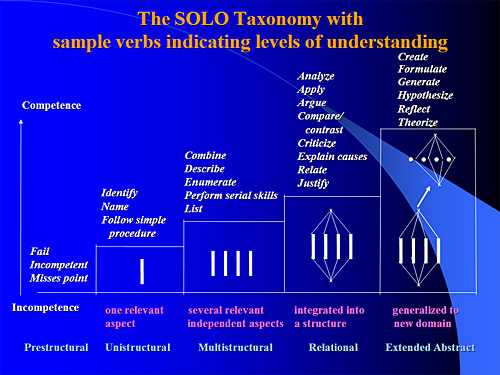Difference between revisions of "Course:OL Delivery:OTL201:Planning"
Jump to navigation
Jump to search
ColinMadland (talk | contribs) |
ColinMadland (talk | contribs) |
||
| Line 41: | Line 41: | ||
#analyze feedback on sample student work in light of SOLO and Hattie & Timperley's model. | #analyze feedback on sample student work in light of SOLO and Hattie & Timperley's model. | ||
#analyze one learning activity from one of your courses and explain how it aligns to the intended learning outcomes of the course, how the activity is strucutred to support student learning and what level of the SOLO taxonomy is required in student responses | #analyze one learning activity from one of your courses and explain how it aligns to the intended learning outcomes of the course, how the activity is strucutred to support student learning and what level of the SOLO taxonomy is required in student responses | ||
| − | + | ##suggest changes to enhance the quality of the activity | |
#provide examples of high quality feedback using appropriate tools or media | #provide examples of high quality feedback using appropriate tools or media | ||
====Resources==== | ====Resources==== | ||
====Assessments==== | ====Assessments==== | ||
Revision as of 14:36, 2 June 2014
Cognitive Presence - Assessment and Feedback to Maximize Student Learning
Overview
explores factors that impact the learner’s cognitive presence and sustain deep learning. You will have opportunities to develop feedback strategies in relation to assessment and those which will encourage deeper student learning.
Outcomes
- analyze the characteristics of ‘cognitive presence’ in an effective online learning environment
- explain the importance of deep approaches to learning in relation to assessment, feedback and student attainment of learning outcomes.
- evaluate the quality of the feedback that they provide for students in light of relevant evidence-based research (SOLO Taxomony and Hattie & Timperley.
- analyze learning activities and their effectiveness to promote deep approaches to learning
- provide high quality feedback using appropriate tools to promote deep approaches to learning.
- establish 3 goals related to improving and enhancing deeper approaches to learning in your courses
- develop a plan for implementing your goals in improving and enhancing deeper approaches to learning in your courses.
Links
Course Overview
Week 1 - Welcome and Intro
Outcome
Activities
- Draw yourself as...?
- Wordle?
Resources
Assessments
Week 2-3 - Deep Approaches to Learning
Outcome
Activities
- Analyze and explain how various qualities of feedback might influence student learning
Resources
Assessments
Week 4-5 - SOLO Taxonomy
Outcome
Activities
- analyze feedback on sample student work in light of SOLO and Hattie & Timperley's model.
- analyze one learning activity from one of your courses and explain how it aligns to the intended learning outcomes of the course, how the activity is strucutred to support student learning and what level of the SOLO taxonomy is required in student responses
- suggest changes to enhance the quality of the activity
- provide examples of high quality feedback using appropriate tools or media
